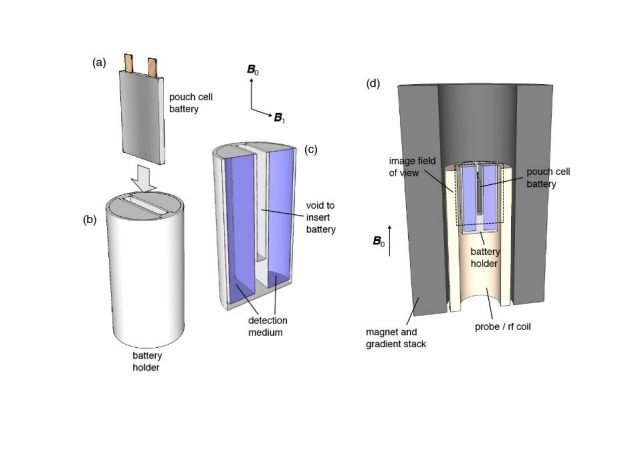May 6, 2018 | News Brief |
“The use of alternative energy and electrically powered vehicles will further increase the demand for better and safer batteries,” said Alexej Jerschow, a professor in New York University’s Department of Chemistry, who led the research team. “However, there are currently only a very limited set of tools available to diagnose a battery’s health without destroying the battery—our non-invasive technique offers a faster and more expansive method for making these assessments.”

Recent malfunctions in hand-held devices and electric vehicles have highlighted the difficulties in designing batteries for these cutting-edge technologies. In addition, engineers often cannot determine the nature of defects or even impending battery failures without taking apart the device, which typically results in its destruction.
In general, magnetic resonance (MR) methods provide the ability to measure tiny changes in magnetic field maps and, as a result, create a picture of what lies inside a structure—for example, MRI (magnetic resonance imaging) can produce images of the human body’s organs in a non-invasive manner.
In their experiments, they examined Li-ion batteries in different states, various levels of charge (i.e., battery life) and conditions (i.e., some damaged and others not). Such cells were prepared by collaborators at RIT’s Battery Prototyping Center. With these cells, the NYU team was able to match magnetic field changes surrounding the batteries to different internal conditions, revealing state of charge and certain defects. These included bent and missing electrodes as well as small foreign objects in the cell, which are flaws that can occur during the normal manufacturing process.
“With future enhancements to this method, it could provide a powerful means of predicting battery failures and battery lifetimes as well as facilitate the development of next-generation high-performance, high-capacity, and long-lasting or fast-charging batteries,” said Jerschow.
The work also included Andrew Ilott, an NYU post-doctoral fellow at the time of the study and now a research investigator at Brisol-Myers Squibb; Mohaddese Mohammadi, an NYU doctoral candidate; and Christopher Schauerman and Matthew Ganter, research scientists at the Rochester Institute of Technology. The research was supported by a grant from the National Science Foundation (CHE-1412064) and NYU’s Technology Acceleration and Commercialization award.
Jerschow and his NYU colleagues have also recently received a $150,000 grant from PowerBridgeNY, a New York State-backed accelerator that supports scientists and entrepreneurs to commercialize clean technologies, to continue to enhance this and related techniques.







